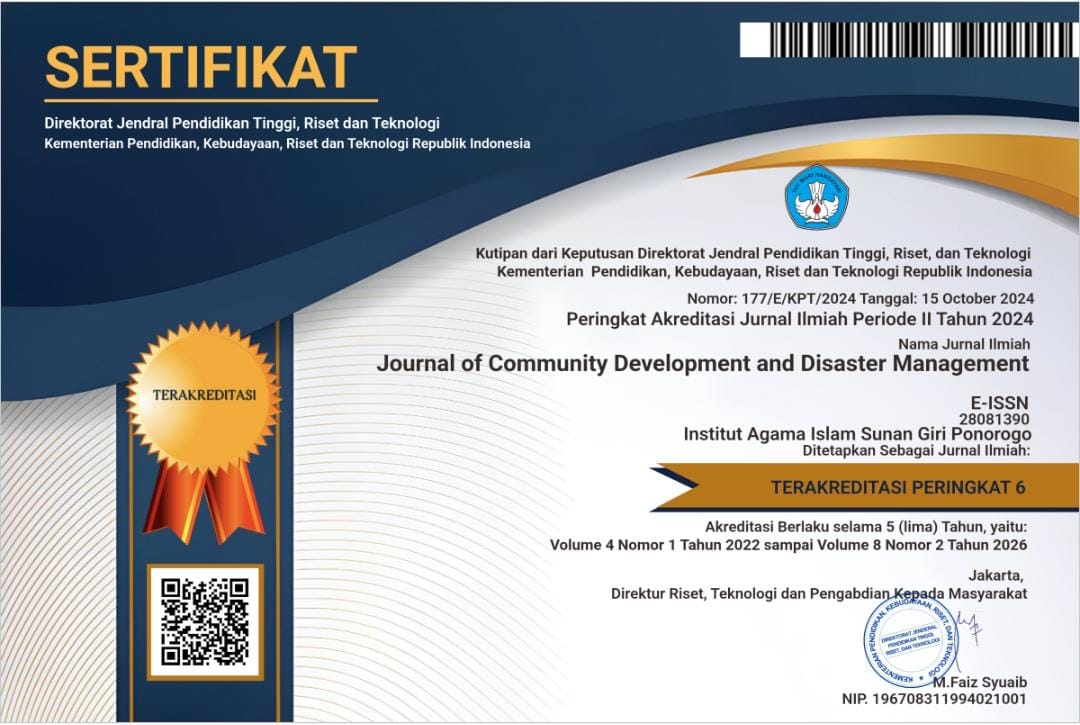Perancangan Sistem Pembangkit Listrik Tenaga Surya (PLTS) Off-Grid Pada Gedung Perkuliahan
Design of Off-Grid Solar Power Plant System (PLTS) in Lecture Building
DOI:
https://doi.org/10.37680/jcd.v7i1.6965Keywords:
Off-Grid, Performance Ratio, PLTSAbstract
Off-Grid Solar Power Plant (PLTS) system planning at Building F of the Sumatra Institute of Technology, South Lampung Regency, Lampung Province is one of the efforts or strategies in reducing the use of conventional electrical energy from the main supplier, namely the State Electricity Company (PLN), and helping to succeed the government's efforts to increase the consumption of new and renewable energy. In PLTS system planning, the aspects that will be analyzed in this research are technical aspects with the help of PVsyst software to collect data regarding technical indicators such as performance ratios and energy production generated by Off-Grid PLTS. In this research, the required land area is 52 m2 from a total of 930 m2 of available land. The simulation results show that the planned rooftop solar system has a capacity of 10.8 kWp using 24 units of AE SOLAR MC144 430-450 W type solar modules, with the capacity of each module being 450 Wp. The PLTS system uses 1 inverter with the type Victron Quattro 48/15000 (15 kW) with a capacity of 15,000 W and uses a battery with the type LUNA2000-15- S0 which has a capacity of 15 kW in each unit. In this study, the solar module received solar irradiation of 4,616 kWh/m2 per day and 1,684 kWh/m2 per year. The production obtained in this study amounted to 14,475 kWh per year. The percentage of the Performance Ratio (PR) value produced by the designed OffGrid PLTS system is 73.01%.
References
Anwar, F., Yunianto, M., & Purnomo, F. A. (2023). Implementasi Sistem Pembangkit Listrik Tenaga Surya Terpusat (Off-Grid) untuk Sumber Energi Mandiri Budidaya Perikanan. 188: Jurnal SEMAR (Jurnal Ilmu Pengetahuan, Teknologi, dan Seni bagi Masyarakat).
Aryanto, N., Jaya, A., & Darmawan, I. (2022). Feasibility Study dan Detail Engineering Design Pembangkit Listrik Tenaga Surya (PLTS) komunal di Universitas Teknologi Sumbawa. Dielektrika – Department of Electrical Engineering University of Mataram, 106-117.
Bayu, H., & Windarta, J. (2021). Tinjauan Kebijakan dan Regulasi Pengembangan PLTS di Indonesia. JEBT: Jurnal Energi Baru & Terbarukan, 123-132.
DEVELOPMENT, SOLAR ENERGY;. (2024). Manfaat Panel Surya. BUMI ENERGI SURYA.
Duffie, J. A., & Beckman, W. A. (2013). Solar Engineering of Thermal Processes (4th ed.). Hoboken: Wiley.
Guna, E. N., & Umar. (2021). Analisis Pemakaian Listrik Pelanggan Menggunakan Sistem Automatic Meter Reading (Amr) Di Pt. Pln (Persero) Ulp Klaten Kota. Simposium Nasional RAPI XX – 2021 FT UMS, 144-151.
Indonesia, K. E. (2017). Rencana Umum Energi Nasional (RUEN). Jakarta: Kementerian ESDM.
Lampung, B. P. (2023). Rencana Umum Energi Daerah (RUED). Lampung: Bappeda Lampung.
Maisarah, U., Andiny, P., & Safuridar, S. (2024). Pengaruh Tingkat Penggunaan Energi Listrik terhadap Pertumbuhan Ekonomi di Indonesia. Jurnal Ekonomi dan Pembangunan Indonesia, 59-68.
Manab, A., H, I. T., Rabiula, A., & Matalata, H. (2022). Perencanaan Pembangkit Listrik Tenaga Surya Sistem Off-Grid di Desa Bungku Kecamatan Bajubang Kabupaten Batanghari Jambi. Journal of Electrical Power Control and Automation, 61-66.
Octavia, D., Hutama, A., Tampoy, D., & Rohmana, R. C. (2023). Studi Potensi Plts Atap Di Makassar Untuk Meningkatkan Penggunaan Energi Terbarukan Dan Mengurangi Emisi Karbon. PETRO: JURNAL ILMIAH TEKNIK PERMINYAKAN, 233-246.
Putri, T. M., Kartini, U. T., Joko, & Tjahyaningtijas, R. R. (2025). Pemodelan Pembangkit Listrik Tenaga Surya Off-Grid untuk Skala Rumah Tangga. Jurnal Teknik Elektro, 16-22.
Yuwono, S., Diharto, D., & Pratama, N. W. (2021). Manfaat Pengadaan Panel Surya dengan Menggunakan Metode On Grid. Energi dan Kelistrikan: Jurnal Ilmiah, 161-171.
Downloads
Published
How to Cite
Issue
Section
License
JCD: Journal of Community Development and Disaster Management rekomendasi pencipta untuk memegang hak cipta tanpa batasan dan batasan pencipta untuk memiliki hak publikasi tanpa batasan, juga pemilik hak komersial atas artikel tersebut adalah pencipta.







